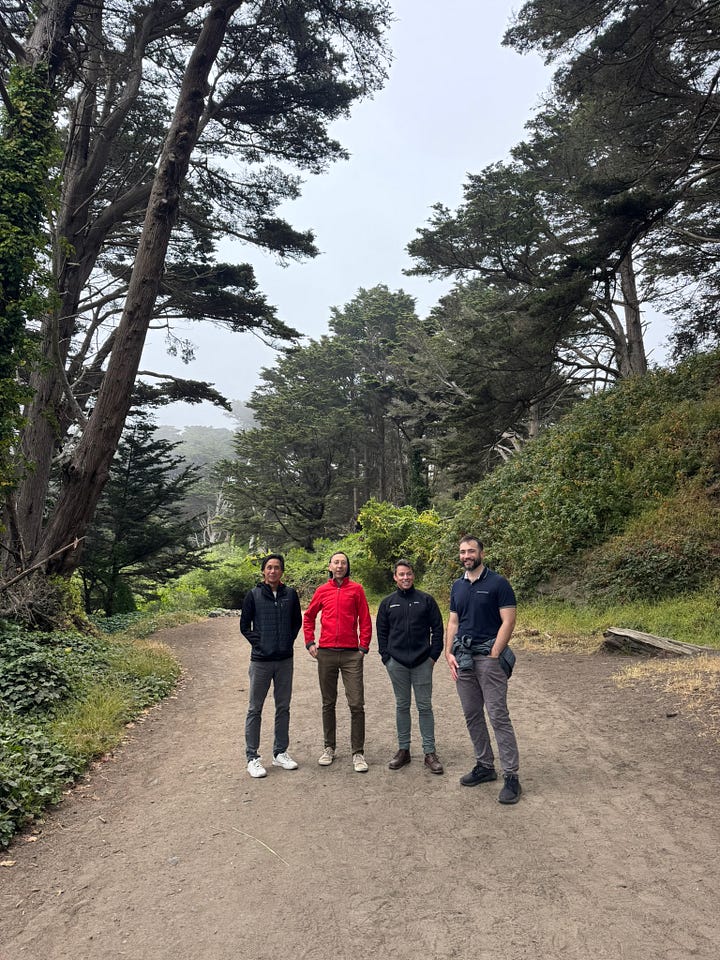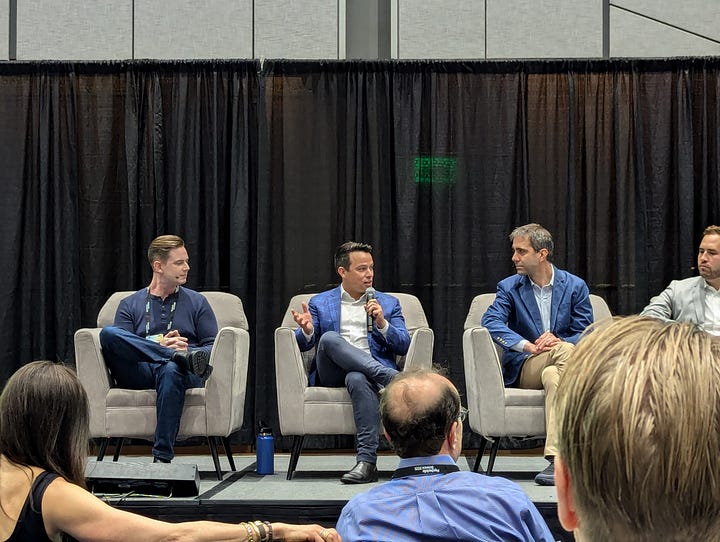Xylo Bio's Neuroscience Newsletter, June 2025
Clinical breakthroughs in psychedelic therapies, Xylo Bio updates, and the latest in serotonergic neuroscience.
Welcome to the June edition of Xylo Bio’s Neuroscience Newsletter. June was a big month for psychedelic and serotonergic research, with a major conference and long-awaited data making headlines. This month, Science in Sixty Seconds unpacks recent topline data from psychedelic trials in depression. You’ll also find key takeaways from new research in Research Updates, and catch up on our latest milestones in Xylo Bio Updates.
Science in Sixty Seconds
Encouraging Results for Psychedelic Therapies in Depression Trials
Psilocybin therapy (COMP360) is successful in Phase 3 TRD
Compass Pathways announced that its landmark Phase 3 trial of COMP360 psilocybin therapy met its primary endpoint for treatment-resistant depression (TRD). This is the first-ever Phase 3 trial of a serotonergic psychedelic, and among the largest psychedelic studies ever conducted, and a true milestone for the field.
TRD affects around 1 in 3 people with depression, a group for whom conventional treatments often fail. Current options are limited and often invasive, including complex pharmacological regimens and electroconvulsive therapy. New, accessible interventions are urgently needed.
Compass’ study, titled COMP005, compared a single 25 mg dose of COMP360 to an inactive placebo in 258 people with TRD. It found that a single dose of COMP360 produced a statistically significant reduction in depression symptoms compared to placebo, 6 weeks after dosing, with no unexpected safety signals or increase in suicidality. Full data are yet to be released, but this early signal is a crucial step toward potential approval. Phase 3 trials are typically the final hurdle before regulatory review and market authorization.
A second Phase 3 trial (COMP006) is underway to replicate and extend these findings. It is comparing a high (25 mg) and medium (10 mg) dose with and low-dose control (1 mg), rather than using an inactive placebo – an approach that could help address blinding concerns and better characterize dose-response.
Notably, Compass’ stock dropped by ~50% following the announcement. This may be because some investors expected a larger effect size, based on the Phase 2 results and general hype. However, the magnitude of COMP360’s effect on the MADRS scale (the gold standard clinician-rated instrument to measure depression symptoms) is comparable to that of Spravato (esketamine) in its Phase 3 trials (see below) – the only other recent innovation approved for TRD. Also, a drop in effect size from Phase 2 to Phase 3 is expected, as larger, more representative trials typically yield more modest estimates (see below).

Moreover, by definition, treatment-resistant depression is harder to treat, and clinical trials in TRD typically show smaller effect sizes than those in non-resistant major depressive disorder (MDD) (see below).

Another important factor to consider is the impact of additional COMP360 doses, which both Phase 3 trials are designed to assess. The option, and expectation, of a second dose may have unintentionally influenced participants to show only partial improvement after the first. Additionally, conducting the study across 32 sites may have introduced variability in ‘set and setting,’ a known driver of psychedelic response, potentially diluting treatment effects. If so, it strengthens the case for non-hallucinogenic serotonergic agents that are less reliant on extrapharmacological context.
But, importantly, any positive signal in a Phase 3 depression trial is impactful, particularly in TRD, where the failure rate is high and therapeutic innovation rare.
5-MeO-DMT (BPL-003) is successful in Phase 2 TRD
More positive news came from Beckley Psytech and Atai Life Sciences announcing that its 5-MeO-DMT candidate, BPL-003, met the primary endpoint in a Phase 2b trial involving 193 people with TRD. Both the 8 mg and 12 mg doses significantly reduced depressive symptoms compared to control, with the 8 mg dose advancing to Phase 3. With a rapid onset and a short, 2-hour treatment window, BPL-003 may integrate well into existing care models built around ketamine-based therapies.

We’re encouraged by these topline results and look forward to the full data sets. It will be important to see how these, and other serotonergic neurotherapeutics, compare – particularly in future head-to-head trials. For now, it’s promising to see multiple programs progressing into late-stage development, expanding the treatment landscape for those living with difficult-to-treat depression.
At Xylo Bio, where we’re developing next-generation neurotherapeutics that selectively target 5-HT2A. These results reinforce the potential of this pathway to deliver safe, effective, and scalable treatments.
For deeper coverage of the announcements, we recommend Psychedelic Alpha’s reporting on COMP360 and BPL-003.
# Drug and study details: Auvelity, dextromethorphan + bupropion, NCT04019704; BPL-003, 5-MeO-DMT (intranasal), NCT05870540; COMP360, psilocybin (oral), NCT05733546, NCT05624268; CYB003, deuterated psilocybin, oral, NCT05385783; Fetzima, Levomilnacipran, NCT00969709; GM-2505, novel 5-HT2A receptor agonist, NCT06236880; Ketamine, racemic ketamine (intramuscular/subcutaneous), ACTRN12616001096448 ; MM-120, LSD (oral), NCT05407064; Psilocybin-AP, psilocybin-assisted psychotherapy, NCT03715127, NCT03866174; R-107, ketamine ER (oral), ACTRN12618001042235; Ruoxinlin, toludesvenlafaxine/ansofaxine, NCT04853407; SPL026, DMT Fumarate (IV), NCT04673383; Spravato, esketamine (intranasal), NCT01998958, NCT02417064, NCT02418585; Trintellix/Brintellix, vortioxetine, Thase et al. Eur Neuropsychopharmacol. 2016; Viibryd, vilazodone, NCT01473394.
Xylo Bio Updates
The Psychedelic Science conference brought researchers, clinicians, and advocates to our hometown, Denver; and our CSO Dr. Sam Banister joined the panel “Breaking New Ground: Next-Generation Drug Development Programs” to discuss what it takes to translate discovery-stage compounds into credible, clinically relevant therapeutics.
Our CEO Josh Ismin and VP of BD Samantha Tabone have been on the move, building partnerships and connecting with the broader biotech ecosystem from Boston to San Francisco.
We’re pleased to officially welcome Dr Liam Adair as Medicinal Chemist at Xylo Bio.
And we’re thrilled to welcome Dr Jack Nguyen to the team as VP of R&D – more on that soon!
Coming up:
Gordon Research Conference: Neurobiology of Psychedelics (Rhode Island, July 13–18) – Dr. Sam Banister, Dr. Lachlan Whish, and Dr. Dilara Bahceci will be presenting.
We’ve just recorded a new podcast episode with Brom Rector and Sam Tabone – Stay tuned for the drop.
Our next Targeted Neuro Talk (TNT) features neuroscientist Professor Robert Malenka discussing the replicability of experimental findings.
CEO Josh Ismin continues his US travels, connecting with collaborators and investors from coast to coast, while CSO Sam Banister will be visiting Sydney, Australia, at the end of July. Reach out if you’d like to connect.
🤝Join the Team:
We are currently hiring for:
Chief Development Officer (San Francisco, CA, flexible)
Photos












Research Updates
Clinical Research
High vs low dose LSD for depression | High-dose LSD-assisted therapy (100 μg + 200 μg) led to greater reductions in depressive symptoms than low-dose LSD (25 μg + 25 μg) in patients with major depressive disorder, with differences most evident in clinician-rated outcomes; a randomized, double-blind trial (N=61). Med
Consensus on setting in psychedelic trials | Experts established 30 consensus-based variables that should be reported to improve transparency and methodological consistency in psychedelic clinical trials – ReSPCT guidelines – using a Delphi method with 89 international experts. Nat Med
Lower 5-HT1A binding in treatment-resistant depression | TRD patients (N=33) had significantly reduced 5-HT1A receptor binding in the dorsal and median raphe nuclei compared to healthy controls (n=44) in a PET study, suggesting a role for brainstem serotonin dysfunction in treatment resistance. Transl Psychiatry
Ketamine therapy for severe depression | Ketamine-psychotherapy led to large, sustained reductions in depression, anxiety, and suicidality in a randomized trial of people with severe TRD (N=32), regardless of music use; with mystical experiences potentially mediating therapeutic effects. Br J Psychiatry
EEG signal complexity predicts ketamine response | Subanesthetic ketamine increased EEG Lempel-Ziv complexity (LZCT) during infusion, and lower baseline occipital LZCT predicted greater short-term symptom improvement in a placebo-controlled trial with 24 MDD patients (21 with TRD). J Affect Disord
Psilocybin for depression in cancer patients | A single 25 mg dose of psilocybin with psychotherapy led to sustained reductions in depression and anxiety in patients with cancer, with effects lasting up to 2 years (N=30). Cancer
5-HT2A maps heartbeats in the brain | Brain regions with strong heartbeat-evoked potentials were enriched in 5-HT2A receptors, suggesting a serotonergic basis for interoceptive heartbeat processing (N=54 epilepsy patients). Cardiovasc Res
[Preprint] LSD's effects on the human brain | LSD was shown to occupy cerebral 5-HT2A receptors, increase cerebral blood flow without arterial dilation, reduce global connectivity, and enhance entropy in brain networks, distinguishing its effects from psilocybin; a PET-MRI clinical trial of 11 healthy volunteers. medRxiv
[Preprint] Psilocybin targets neural synchrony in depression | Psilocybin increased brain signal diversity and reduced depression severity in people with major depressive disorder. In this clinical trial of 43 participants, EEG data showed that psilocybin induced greater changes in neural synchrony than placebo, and these changes predicted symptom improvement. medRxiv
[Preprint] Meta-analysis of psychedelics vs antidepressants | Psychedelic-assisted therapy wasn’t more effective than open-label antidepressants in treating major depression when both were similarly unblinded, reports a meta-analysis of 24 trials (8 PAT, 16 tAD). PsyArXiv
Preclinical Research
Psilocybin boosts fear extinction in mice | Psilocybin enhanced fear extinction by suppressing fear-active neurons and recruiting extinction-active neurons in the retrosplenial cortex. Nat Neurosci
5-HT1A drug shows promise for pain | ST171, a novel functionally selective 5-HT1A receptor agonist, was shown to activate Gi/o signalling pathways without recruiting β-arrestin or activating Gs, leading to analgesic effects in both acute and chronic pain mouse models. Sci Adv
Photoswitchable compound targets 5-HT2A signalling | A novel light-sensitive tryptamine ligand preferentially activated β-arrestin2 over mini-Gq at 5-HT2A receptors in vitro, offering a pathway-selective tool to study psychedelic receptor signalling. J Med Chem
5-HT2A efficacy distinguishes psychedelic drugs | Psychedelic and non-psychedelic 5-HT2A agonists showed no differences in signalling bias but were separated by efficacy, with non-psychedelics exhibiting weaker Gq and β-arrestin2 activation in vitro. Br J Pharmacol
Psilocybin + NMDAR modulators reduce side effects | Co-administering psilocybin with D-serine or D-cycloserine reduced head twitch response and MK-801-induced hyperlocomotion while increasing synaptic protein levels in certain mouse brain regions. Transl Psychiatry
Psilocybin’s suicide-prevention mechanisms | Psilocybin was found to strongly bind to four suicide-related molecular targets (HTR2A, HTR2C, HTR7, and PRKACA) in a computational and network analysis study. Transl Psychiatry
Psilocybin effects in stressed mice | Psilocybin (1 mg/kg) reversed depressive- and anxiety-like behaviours in mice exposed to chronic stress and increased cortical 5-HT2A receptor expression but did not restore BDNF or normalise HPA axis function. Transl Psychiatry
How serotonin shapes psilocybin’s brain effects | Increased serotonin levels reduced the behavioural effects of psilocybin in mice, while serotonin depletion or modulation of 5HT1A/5HT2A receptors altered its impact. Int J Neuropsychopharmacol
Ergotamine boosts circadian and pain responses | Ergotamine enhanced circadian rhythm amplitude and reduced nitroglycerin-induced pain sensitivity in mice, particularly when administered during the day, and these effects were mediated by serotonin 1D and 2C receptors. J Headache Pain
Tracking serotonin receptor signaling with fluorescent probe | A hallucinogenic ligand at the 5-HT2A receptor caused slower but prolonged PI(4,5)P2 depletion compared to a non-hallucinogenic ligand, suggesting early differences in signalling dynamics; measured using a novel live-cell fluorescent probe to visualize lipid dynamics in neurons. Chem Sci
G protein control of arrestin pathway at 5-HT2A | G protein signalling was required for arrestin-dependent ERK activation via the 5-HT2A receptor, establishing a unidirectional interplay between biased signalling pathways. Biochem Pharmacol
Psilocin promotes synapse growth and gene expression | Psilocin increased synaptic density and Arc gene expression in cultured rat neurons, showing neuroplastic effects comparable to ketamine and lithium. LSD and DMT did not affect synaptogenesis, and fluoxetine only upregulated IEGs without altering synaptic markers. J Psychopharmacol
Psilocybin reduces depression in stressed rats | Psilocybin reduced despair-like behaviour and cognitive deficits in a rat model of treatment-resistant depression and reversed stress-induced reductions in thyroid-stimulating hormone. It also identified potential involvement of the endocannabinoid system in psilocybin’s antidepressant-like effects. Sci Rep
Reviews and Editorials
Offering psychedelic treatments before assisted dying for psychiatric conditions | This editorial argues that patients with psychiatric conditions should be granted access to potentially life-preserving psychedelic therapies before being considered for physician-assisted dying, highlighting a critical ethical and policy gap in current healthcare systems. JAMA Psychiatry
Targeting the 5-HT2A receptor for developing psychedelic drugs and beyond | This review explores the structure, pharmacology, and functional selectivity of the 5-HT2A receptor, highlighting its role in psychedelic drug action and potential for developing novel therapeutics beyond psychiatry. Pharmacol Rev
There’s more than one way to bring health back: Divergent effects of psilocybin and escitalopram treatment on emotional brain function in depression | This editorial discusses emerging evidence that psilocybin and escitalopram produce distinct changes in emotional brain processing in people with depression, suggesting divergent neurobiological mechanisms that may support different therapeutic pathways. Am J Psychiatry
Neurocognitive effects of psilocybin: A systematic and comprehensive review of neuroimaging studies in humans | This systematic review synthesises findings from 81 neuroimaging studies showing that psilocybin induces acute and sustained changes in brain activity and connectivity, which may underlie its therapeutic effects in psychiatric conditions. Neurosci Biobehav Rev
Neuropsychopharmacology of hallucinogenic and non-hallucinogenic 5-HT2A receptor agonists | This review examines the pharmacological differences between hallucinogenic and non-hallucinogenic 5-HT2A receptor agonists, exploring how biased signalling and neuroplasticity may underpin their shared therapeutic potential despite divergent subjective effects. Br J Pharmacol
Psychedelics, entactogens and psychoplastogens for depression and related disorders | This review examines how psychedelics, entactogens, and other psychoplastogens exert rapid antidepressant and anxiolytic effects by targeting neuroplasticity and neuromodulatory pathways, supporting their potential use in treating depression, PTSD, and anxiety as biologically rooted brain disorders. Br J Pharmacol
Can the gut-brain axis provide insight into psilocybin's therapeutic value in reducing stress? | This review explores how psilocybin may influence stress-related disorders by modulating the gut-brain axis, including interactions with the microbiome, enteric nervous system, and hypothalamic-pituitary axis, highlighting the potential for a more integrated understanding of its therapeutic effects. Neurobiol Stress
Clinical conceptualisation of PTSD in psilocybin treatment: disrupting a pre-determined and over-determined maladaptive interpretive framework | This review proposes a novel clinical framework for understanding how psilocybin may disrupt maladaptive cognitive patterns in PTSD, potentially enabling therapeutic change through its subjective and neurobiological effects. Ther Adv Psychopharmacol
Classic psychedelics in pain modulation: Mechanisms, clinical evidence, and future perspectives | This review outlines the emerging role of classic psychedelics such as psilocybin, LSD, and DMT in modulating chronic pain through serotonergic, neuroplastic, and anti-inflammatory mechanisms, while emphasising the need for rigorous clinical trials to validate their therapeutic potential. ACS Chem Neurosci
Separate or inseparable? Serotonin and dopamine system interactions may underlie the therapeutic potential of psilocybin for anorexia nervosa | This review proposes that psilocybin’s therapeutic effects in anorexia nervosa may stem from its ability to enhance cognitive flexibility and reward processing via coordinated modulation of serotonin and dopamine systems, highlighting the need for further mechanistic research. Physiol Behav
New Clinical Trial Registrations
LSD (26 µg) vs placebo | Major Depressive Disorder (N=48) | Mood Effects of Serotonin Agonists: Depression | Sponsor: University of Chicago | NCT07017478
Psilocybin (30 mg vs 10 mg) | Obsessive-Compulsive Disorder (N=20) | Psilocybin for Treatment of Obsessive Compulsive Disorder | Sponsor: Francisco A Moreno | NCT06992999
MDMA + psilocybin (exact dosages not disclosed) | Post-traumatic Stress Disorder (N=40) | Psilocybin and MDMA for Post-traumatic Stress Disorder (PTSD) | Sponsor: Johns Hopkins University | NCT06989957
Ketamine (0.5 mg/kg) + preferred music vs therapist-selected music vs silence | Chronic Pain (N=25) | Investigating the Synergistic Potential of Music as an Adjunct to Ketamine Therapy for Chronic Noncancer Pain (Open Label) | Sponsor: McGill University | NCT06994559
Jump back to:






